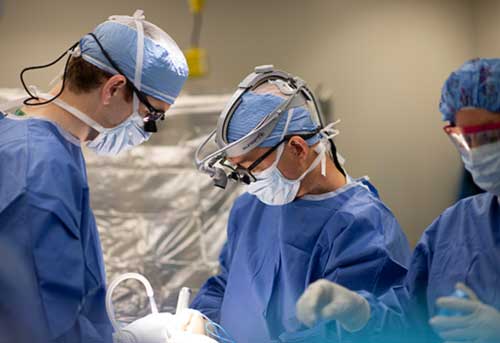A Review of Spine Problems That Often Result in Surgical Treatments
When traditional treatments stop working to ease persistent symptoms,Spine conditions such as herniated discs, spine stenosis, and degenerative disc disease often necessitate surgical interventions. These problems not only cause significant discomfort however can additionally badly harm day-to-day performance and overall lifestyle. Comprehending the subtleties of each problem and the equivalent medical options, such as discectomy or back blend, is important for efficient management. As we check out these problems even more, it comes to be evident that the decision-making procedure surrounding surgical therapy is diverse and warrants careful factor to consider.
Herniated Discs
Although several people with herniated discs may locate alleviation with conservative therapies, surgical treatment comes to be a needed factor to consider when signs and symptoms persist or intensify - best spine surgeons in st louis mo. A herniated disc takes place when the soft inner gel of a spine disc protrudes via its external layer, potentially pressing close-by nerves and leading to discomfort, feeling numb, or weak point in the extremities
Conventional monitoring usually includes physical treatment, pain medications, and corticosteroid shots, which aim to lower swelling and boost feature. In situations where these methods stop working to minimize devastating symptoms, surgical alternatives might be explored.
The most common procedure for herniated discs is a discectomy, which entails the elimination of the herniated portion of the disc to ease stress on the impacted nerve origin. In more severe situations, spine blend may be required to stabilize the influenced vertebrae.
Patients are advised to talk about the possible dangers and benefits of surgical treatment with their healthcare service provider to make a notified decision. Inevitably, the objective of any kind of medical treatment is to restore function, relieve discomfort, and boost total quality of life for individuals experiencing herniated discs.
Spine Constriction
Spine constriction takes place when the rooms within the back slim, causing raised stress on the spine cable and nerves. This problem can create in various areas of the spinal column, consisting of the cervical and lumbar locations, often due to age-related adjustments, such as degenerative disc condition, joint inflammation, or thickening of ligaments.
People with back constriction may offer with signs and symptoms that include pain, pins and needles, prickling, or weak point, mainly in the legs or arms. These signs and symptoms can be aggravated by activities that involve standing or strolling, typically leading individuals to seek relief via conventional treatments like physical treatment, medications, or epidural steroid shots.
Nevertheless, when these non-surgical treatments fail to supply ample relief, medical choices might be taken into consideration. Typical surgical treatments for spine constriction consist of laminectomy, which entails the elimination of part of the vertebra to reduce stress, and spine blend, which stabilizes the afflicted location.
Spondylolisthesis
Spondylolisthesis takes place when one vertebra slides ahead over another, bring about misalignment of the spinal column. This condition can arise from various elements, including hereditary problems, injury, or degenerative adjustments in the spinal column. It is most commonly observed in the back area, especially at the L4-L5 and L5-S1 degrees.

Therapy alternatives vary based upon the severity of the slippage and the signs offered. Conventional steps, consisting of physical therapy, pain administration, and activity alteration, are usually the first line of defense. However, when non-surgical methods fail to ease symptoms or when considerable nerve compression is present, medical intervention may be required. Surgical choices can include spinal combination or decompression treatments, targeted at recovering positioning and reducing neurological signs and symptoms. Early medical diagnosis and proper monitoring are important for optimum outcomes in clients with spondylolisthesis.
Degenerative Disc Disease

The condition can be diagnosed through a mix of scientific examination, imaging studies, and patient background. When these techniques stop working to provide ample alleviation, surgical treatments may be considered.
Surgical choices for DDD may consist of spinal blend or synthetic disc substitute, aimed at maintaining the impacted sector and minimizing discomfort (best spine surgeons in st louis mo). Eventually, the selection of treatment is embellished, taking into consideration the extent of the condition, person health, and way of life factors
Spine Lumps

What variables add to the advancement of growths within the back, and just how do they manifest in patients? Spinal growths can develop from numerous variables, including genetic predisposition, environmental influences, and pre-existing medical conditions. They can be classified as main growths, stemming in the back, or second lumps, which spread out from various other areas of the body. Individuals might offer with a series of signs and symptoms, consisting of local discomfort, neurological deficiencies, weak point, or adjustments in digestive tract and bladder feature, relying on the growth's dimension and place.
Surgical treatment might be required Get the facts to relieve signs, get a biopsy, or eliminate the lump entirely. The objective of surgical procedure is frequently to unwind neural elements and maintain the back. Early discovery and intervention are important for enhancing end results in clients with spinal growths.
Verdict
In recap, spinal column conditions such as herniated discs, spine constriction, spondylolisthesis, degenerative disc illness, and spinal growths often demand medical treatment as a result of their potential to trigger substantial discomfort and practical problems. While conventional treatments might offer short-term relief, medical options become vital when signs persist or aggravate. Timely diagnosis and intervention play an important function in recovering feature and improving the lifestyle for damaged people, underscoring the value of extensive back care.

Comments on “The Importance of Follow-Up Care with the Best Spine Surgeons in St Louis MO”